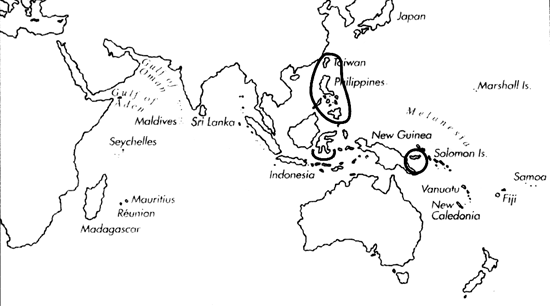Range: Taiwan to Philippines; Papua New Guinea; recently reported from Makassar (Indonesia).
Description: Medium-sized to moderately large, moderately solid to solid. Last whorl ventricosely conical to pyriform; outline convex at adapical half to two-thirds, straight to slightly concave (right side) or concave (left side) below. Shoulder angulate, with 15-20 distinct to weak tuberkles. Spire of low to moderate height, outline concave or sigmoid. Larval shell of 3 or more whorls, maximum diameter about 0.9 mm. Teleoconch spire whorls tuberculate. Teleoconch sutural ramps slightly concave, with 0-2 increasing to 4-7 spiral grooves. Last whorl with strong, often granulose spiral ribs or ribbons; grooves between axially striate and some containing 1-2 spiral threads.
| Shell Morphometry | ||
|---|---|---|
| L | 46-70 mm | |
| RW | 0.17-0.54 g/mm | |
| RD | 0.56-0.68 | |
| PMD | 0.75-0.85 | |
| RSH | 0.11-0.21 | |
Ground colour white. Last whorl with spiral rows of separate to fused brown dots, spots, and bars on ribs and ribbons, concentrated in 2 incomplete spiral bands, below shoulder and above centre. Larval whorls and first 2-3 postnuclear sutural ramps usually beige to brown. Following ramps with sparse brown spots. Aperture white.
Periostracum greyish brown, thin, translucent, smooth.
Radular teeth about 0.01 5 of shell length, with an adapical barb opposite a blade; serration comprising about 27 denticles (Röckel, 1986).
Habitat and Habits: In 60-400 m.
Discussion: Although C. rolani was described in 1986, Dayrit recognized the species already in 1966, but misidentified it as C. granifer Reeve. Subsequently most authors considered it to be conspecific with C. grangeri (e.g. Walls, [1979]); for distinctions see the Discussion of the latter species. C. sulcatus typical form and form samiae differ from C. rolani in their often less ventricose last whorls (PMD 0.80- 0.93) that have almost straight rather than convex outlines adapically and are not pyriform; their shoulders have less (10-14) but broader tubercles or bulges, and their perios traca are thicker, less translucent or opaque, and not smooth. All forms of C. sulcatus, except form samiae, can be distinguished from C. rolani by the absence of brown dots, spots, and bars from their last whorls.

C. rolani range map
This section contains verbatim reproductions of the accounts of 316 species of Conus from the Indo-Pacific region, from Manual of the Living Conidae, by Röckel, Korn and Kohn (1995). They are reproduced with the kind permission of the present publisher, Conchbooks.
All plates and figures referred to in the text are also in Röckel, Korn & Kohn, 1995. Manual of the Living Conidae Vol. 1: Indo-Pacific Region.
The range maps have been modified so that each species account has it own map, rather than one map that showed the ranges of several species in the original work. This was necessary because each species account is on a separate page on the website and not confined to the order of accounts in the book.